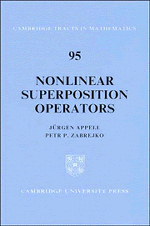Book contents
- Frontmatter
- Contents
- Preface
- Chapter 1 The superposition operator in the space S
- Chapter 2 The superposition operator in ideal spaces
- Chapter 3 The superposition operator in Lebesgue spaces
- Chapter 4 The superposition operator in Orlicz spaces
- Chapter 5 The superposition operator in symmetric spaces
- Chapter 6 The superposition operator in the spaces C and BV
- Chapter 7 The superposition operator in Hölder spaces
- Chapter 8 The superposition operator in spaces of smooth functions
- Chapter 9 The superposition operator in Sobolev spaces
- Bibliography
- List of Symbols
- Subject Index
Chapter 7 - The superposition operator in Hölder spaces
Published online by Cambridge University Press: 05 February 2012
- Frontmatter
- Contents
- Preface
- Chapter 1 The superposition operator in the space S
- Chapter 2 The superposition operator in ideal spaces
- Chapter 3 The superposition operator in Lebesgue spaces
- Chapter 4 The superposition operator in Orlicz spaces
- Chapter 5 The superposition operator in symmetric spaces
- Chapter 6 The superposition operator in the spaces C and BV
- Chapter 7 The superposition operator in Hölder spaces
- Chapter 8 The superposition operator in spaces of smooth functions
- Chapter 9 The superposition operator in Sobolev spaces
- Bibliography
- List of Symbols
- Subject Index
Summary
The literature on the superposition operator in Hölder spaces is almost as vast as that in Lebesgue spaces. However, the “behaviour” of the superposition operator in Hölder spaces is quite different from that in spaces of measurable functions, or in the space C.
The topics discussed in the present chapter are the following: after formulating a (quite technical) necessary and sufficient acting condition, we discuss the boundedness of F. Interestingly, acting implies boundedness only in case f = f(u), but not in case f = f(s,u). Quite amazing is the fact that the operator F may act in a Hölder space, although the generating function f is not continuous (and thus F does not act in the space C!).
As far as the continuity of F is concerned, things are even worse: even in the autonomous case f = f(u) the operator F may act between two Hölder spaces (and hence be bounded), but not continuous. On the other hand, it is possible to describe the “points of continuity”, and to give conditions for both continuity and uniform continuity on bounded sets.
Another surprising fact concerns the Lipschitz and Darbo conditions, which in all spaces considered so far turned out to be equivalent. In Hölder spaces, the operator F may satisfy a Darbo condition for a reasonably large class of nonlinearities f, while a global Lipschitz condition for F leads, roughly speaking, necessarily to affine functions f (in u).
- Type
- Chapter
- Information
- Nonlinear Superposition Operators , pp. 181 - 204Publisher: Cambridge University PressPrint publication year: 1990

